

Strategic planning is essential for businesses that aim to grow and achieve long-term success. It involves the creation of detailed strategies and frameworks that guide an organization toward its goals.
Is your business model working? Find out with benchmarks
A robust strategic plan serves as a roadmap for the entire organization, helping leaders navigate market conditions, industry challenges, and internal processes. With the ever-changing business environment, companies need to adapt their approach by using strategic planning models and frameworks that provide direction and ensure sustainable growth.
In this blog, we will explore the following topics:

A strategic planning framework is a vital tool that assists businesses in organizing their strategy formulation, setting long-term strategic goals, and ensuring the alignment of key activities with organizational vision.
It provides a structure that guides businesses in achieving growth by analyzing external and internal factors and identifying key performance indicators (KPIs). With the right strategic framework, businesses can understand the competitive environment, recognize their strengths and weaknesses, and develop customized solutions that address specific challenges.
Strategic planning frameworks help businesses assess both internal processes and external market conditions, facilitating decision-making that aligns with their strategic direction. By considering the internal and external factors, a company can craft a strategy that aligns its business goals with market trends, improving its chances of remaining competitive in an ever-changing market.
Assess your business strategy with benchmarks here
Strategic planning models are structured approaches to help organizations define and reach their goals. They provide a clear pathway to achieving competitive advantage by guiding organizations through their strategic planning process.
These models break down complex business decisions into manageable steps and make it easier for leadership teams to focus on their objectives, whether it’s market penetration, product development, or expansion into new markets.
By using strategic planning models, organizations can assess their current position in the market, identify growth opportunities, and select the most suitable approach for future success. These models offer critical insights that drive businesses to make data-driven decisions, ensuring better resource allocation and improved financial performance.

The Balanced Scorecard (BSC) is one of the most widely used strategic planning frameworks in the world. Developed by Drs. Robert Kaplan and David Norton, this framework helps businesses translate their strategic objectives into measurable actions. It evaluates performance across four key perspectives: financial, customer, internal business processes, and learning and growth.
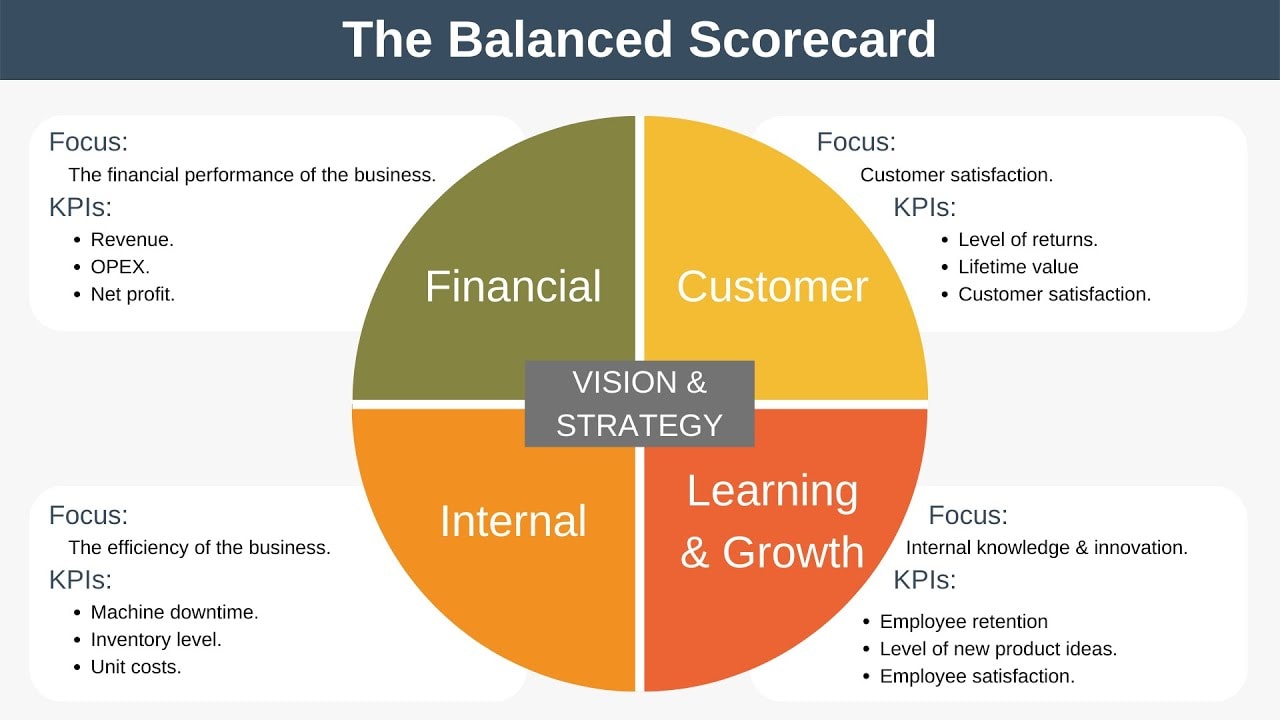
By using a Balanced Scorecard, organizations can monitor their progress toward achieving strategic goals and ensure alignment between day-to-day operations and long-term objectives. It enables businesses to focus on the drivers of future performance while monitoring key results that will help in the achievement of business strategy.
The Balanced Scorecard also helps organizations communicate strategy clearly to all stakeholders, enhancing performance and ensuring the strategic plan is executed effectively. Here are the key benefits of a BSC:
SWOT analysis is a strategic planning model used to assess the internal and external factors influencing a business’s performance. It evaluates the organization’s strengths, weaknesses, opportunities, and threats to provide a snapshot of its current position in the market. The SWOT analysis helps businesses identify key areas for improvement, set strategic goals, and discover new growth opportunities.
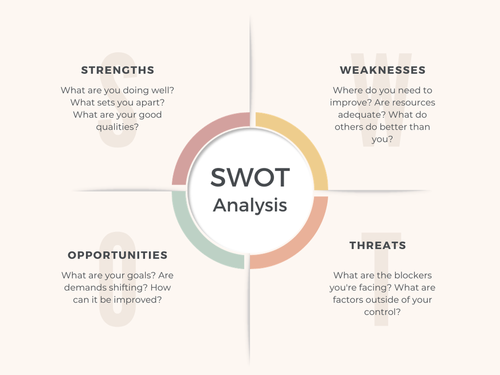
A SWOT analysis encourages strategic thinking by enabling companies to identify their competitive edge and understand where to prioritize investments. This model is commonly used as part of the early stages of strategic planning to assess the broader environment and evaluate potential risks or opportunities that might affect organizational goals. Here are the key benefits of a SWOT analysis:
Porter’s Five Forces is a strategic management tool that assesses the competitive intensity and attractiveness of an industry. By analyzing the bargaining power of suppliers and buyers, the threat of new entrants, the threat of substitutes, and the competitive rivalry among existing firms, Porter’s Five Forces enables businesses to identify the strategic forces at play within their industry.
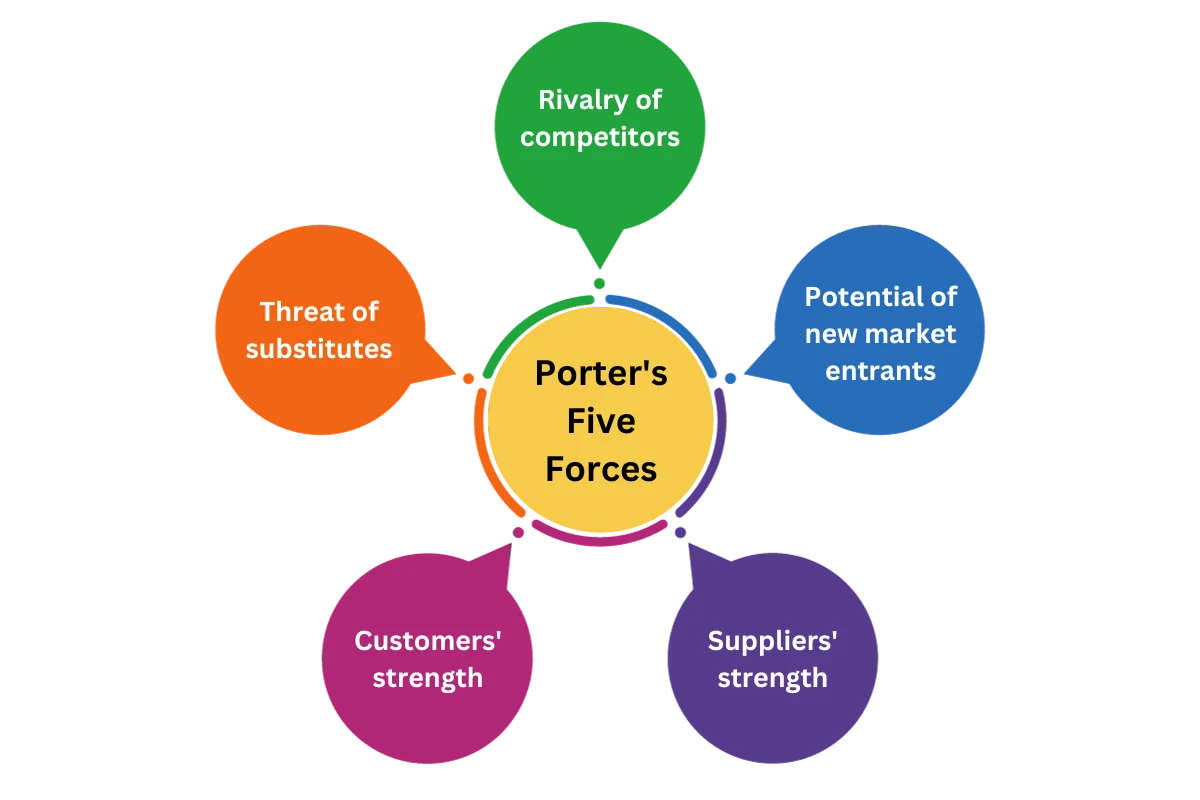
This model helps businesses understand the competitive dynamics in their market and allows them to develop strategies that mitigate risks from competitive rivalry and external factors such as government regulations.
By considering these forces, businesses can create effective market penetration strategies and assess industry attractiveness, which aids in identifying new market opportunities. Here are the key benefits:
The Ansoff Matrix is a strategic framework that helps organizations assess their growth options based on their products and markets. It outlines four key growth strategies: market penetration, market development, product development, and diversification.
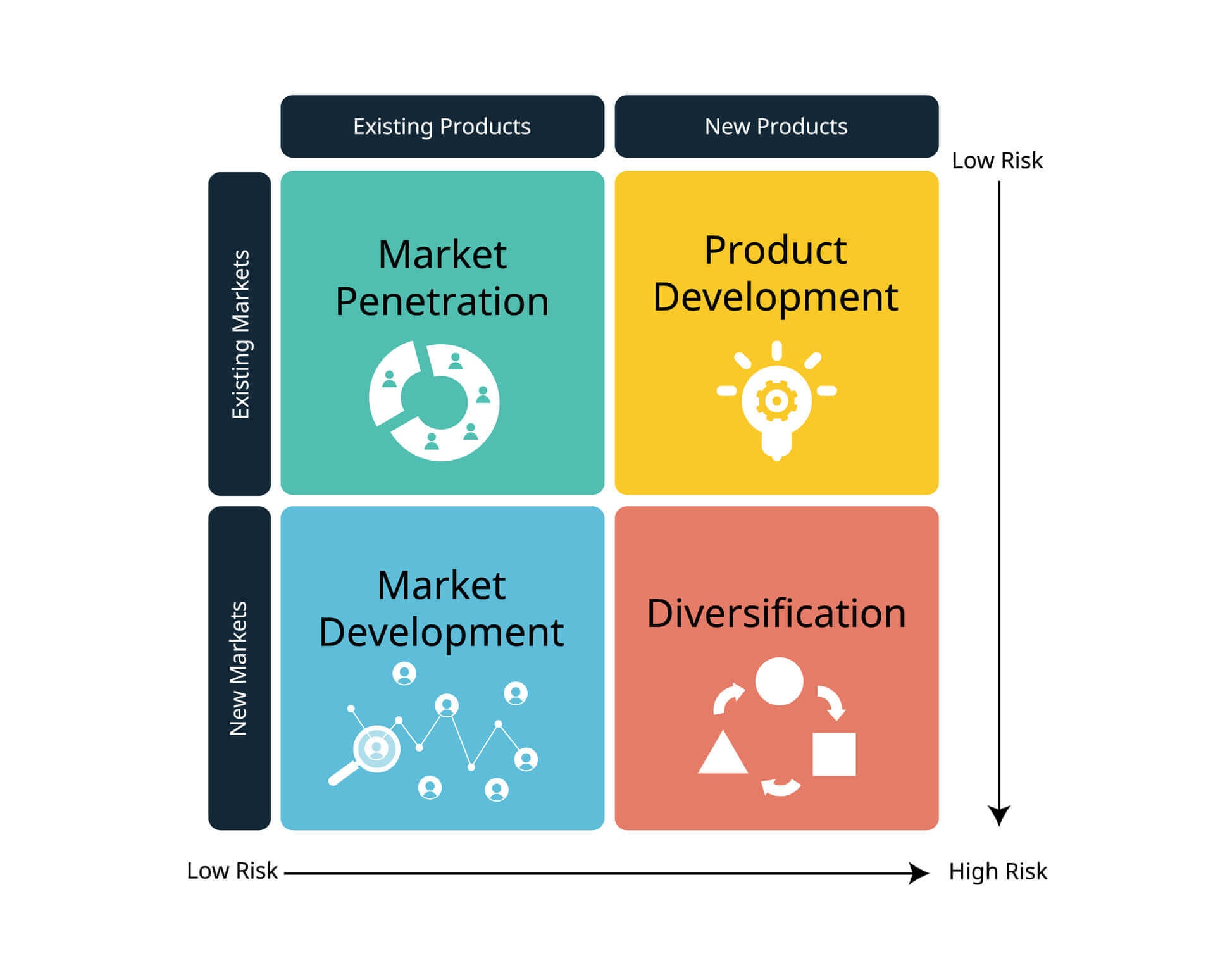
By using the Ansoff Matrix, businesses can explore new growth opportunities in both existing and new markets, ensuring they adopt the most effective growth strategy. Whether aiming to enter new markets or innovate existing products, the Ansoff Matrix helps businesses identify the level of risk and potential reward associated with different strategic approaches. Here are the key benefits:
Value Chain Analysis is a strategic framework used to analyze internal business processes and identify areas where a business can create value for its customers. By examining every stage of the production and delivery process, businesses can identify opportunities to optimize operations, improve efficiency, and gain a competitive edge.
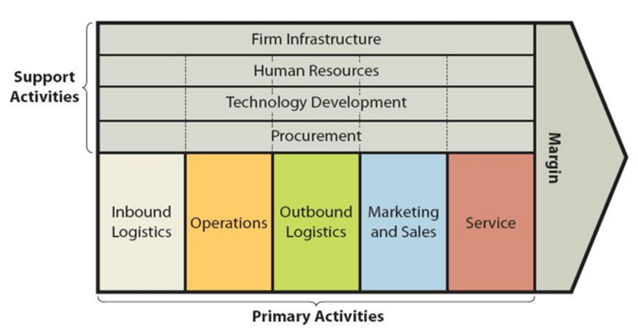
Value Chain Analysis helps organizations streamline their internal processes and create tactical solutions that increase customer value and satisfaction. It involves a deep dive into inbound logistics, operations, outbound logistics, marketing and sales, and services, all of which are crucial components for a sustainable transformation. Here are some of the key benefits for this kind of analysis:
Curious about benchmarking? Compare your company
Once businesses have selected the most appropriate strategy and framework model, it is essential to follow a structured strategic planning process. The strategic planning process involves defining the company’s vision, mission, and values, conducting market research, analyzing competitors, and setting long-term strategic goals.
A comprehensive planning process includes SWOT analysis, PEST analysis, and competitor benchmarking to assess both internal and external factors. When performing competitor benchmarking it is best to use a trusted third-party benchmarking data provider, such as CompanySights.
By following a strategic planning process, businesses can identify growth opportunities, assess risks, and prioritize investments that align with their strategic direction. The process also includes setting key results, monitoring progress through performance metrics, and adjusting the strategy to meet evolving market conditions.

Developing a strategy is just the first step - The real challenge lies in effective implementation. Implementation of a business strategy requires a structured approach, focusing on internal processes, resource allocation, and aligning the leadership team with the strategic plan. It also involves communicating the strategy across the entire organization, ensuring that every business unit understands its role in achieving the desired business outcomes.
It is important for organizations to be flexible and make adjustments to the strategy as market conditions change. The strategic plan should not be static but rather adaptable to new challenges, opportunities, and competitive dynamics. Scenario planning is often used to anticipate potential market shifts and refine the business strategy accordingly.
Explore trusted benchmarks for evaluating any business
As businesses grow, so do the complexities of their strategic planning needs. Multi-business corporations often face challenges in aligning diverse business units under a single strategic framework. These challenges require careful consideration of internal factors, such as organizational culture, and external factors, including shifting market trends and government regulations.
Organizations must also address challenges such as competitive rivalry and the bargaining power of suppliers and customers. By using the appropriate strategy frameworks and models, companies can overcome these challenges, identify growth threats, and continuously improve their business operations.

To ensure the effectiveness of your strategic planning process and guarantee the alignment of your organization’s goals with market conditions, it’s essential that you implement a few best practices. These practices not only optimize the strategic planning framework, but also ensure continuous improvement, helping the business stay agile and competitive in a dynamic environment.
Below are several best practices that will help you implement your business strategy successfully:
Strategic plans should not be set in stone. Business environments, consumer behaviors, and industry dynamics are constantly evolving. To ensure your strategy stays relevant, it’s essential to review and update your strategic plan regularly. This allows you to assess whether your existing strategy is still aligned with your business's vision and market needs.
A periodic review can help you identify any external factors, such as market trends or government regulations, that might require adjustments to your plan. It also gives you an opportunity to revisit the objectives and key results you set initially, ensuring they continue to meet your strategic goals.
One of the most effective tools for executing a strategic plan is strategy mapping. A strategy map is a visual tool that helps link your organization’s goals with specific actions and KPIs. By using strategy maps, you can ensure that every department or business unit is aligned with the overarching organizational strategy.
A clear strategy map helps clarify how each individual team’s actions contribute to achieving the company’s strategic objectives, thus improving organizational focus. It also aids in prioritizing resources, tasks, and investments across the entire organization, ensuring that everyone understands their role in driving business success.
Every organization is unique, and therefore, one single strategic planning framework may not always be sufficient to address all of your business’s needs. Some businesses combine elements from multiple strategic frameworks to create a more tailored approach to their strategic planning.
For instance, you might use a Balanced Scorecard for performance monitoring while also incorporating SWOT analysis to identify growth opportunities. There is also the possibility to consider using other frameworks in parallel.
This hybrid approach allows you to benefit from the strengths of different models, making it easier to address various aspects of the business environment. A combination of strategy frameworks can give you more flexibility to adjust to challenges and opportunities in real-time.
In today’s digital age, businesses must rely on technology to stay competitive. Using data analytics and business intelligence software provides real-time insights into organizational performance. This data can be used to track progress against your strategic plan, identify areas for improvement, and make data-driven decisions that enhance organizational performance.
By leveraging the power of data analytics, you can obtain deeper insights into customer behavior, operational efficiency, and market trends. These insights allow you to make better-informed decisions, forecast market conditions, and ensure you are making the most of your growth opportunities.
Customer value should always be at the core of your business strategy. Providing exceptional customer experiences directly correlates with long-term market success. Focus on building customer loyalty and satisfaction by ensuring that your products and services deliver true value to your customers. A customer-centric approach can significantly improve your market share and position your business as a leader in your industry.
Additionally, businesses that focus on customer value can better identify and serve existing markets or create strategies to expand into new markets. By consistently gathering customer feedback and adapting your offerings, you not only enhance customer satisfaction but also ensure that your products and services remain relevant and competitive.
Anticipating change and managing risks are critical to business success. Scenario planning is a strategic tool that allows businesses to simulate different future scenarios, helping them prepare for various possible outcomes. Whether it’s changes in the competitive landscape, regulatory shifts, or technological advances, scenario planning enables businesses to be more adaptable and proactive.
By considering different future scenarios, companies can identify potential growth threats, make more informed decisions, and ensure the organization is equipped to handle uncertainties. This proactive approach minimizes surprises and helps businesses respond faster to market changes.
The journey to business success requires constant monitoring of progress toward strategic goals. As part of your strategic planning process, you must regularly assess whether you are achieving your desired business outcomes. By using performance metrics and KPIs, businesses can evaluate their performance against the set targets and make adjustments where needed.
Continuous performance monitoring helps ensure that business goals remain on track and that the organization is responsive to challenges and opportunities. Key results tracking ensures that all business units are contributing effectively to the organization’s overarching strategic direction.
Ready to benchmark your business? Get started here
Strategic planning is the backbone of business growth. By implementing the right strategy and framework models, organizations can navigate complexities, identify growth opportunities, and achieve long-term success. A strategic planning framework provides structure and direction, while strategic planning models offer actionable steps for companies to follow.
By mastering the abovementioned strategic frameworks - Balanced Scorecard, SWOT analysis, Porter’s Five Forces, Ansoff Matrix, and Value Chain Analysis - businesses can stay ahead of market trends, enhance operational efficiency, and prioritize investments that drive sustainable growth.
With a clear strategic direction and a robust planning process, businesses can achieve their desired outcomes, optimize their internal processes, and stay competitive in a rapidly evolving business environment.
.svg)
Download a copy of our latest all industry report with data to benchmark the Finance, HR, IT and Marketing functions.
Insights are just around the corner.
.svg)
.svg)